Text
Crisis of Black Women's Health
Gabriela Casillas
Black women have faced disparities in healthcare for many years. Historically Black Women have largely been excluded from clinical research. Black women have always had to navigate this complex system of inequalities and systemic challenges in healthcare, where everyone deserves equal access and quality. It has been a compelling narrative that intertwines systemic biases, historical injustices, and the urgent need for change in the Black Women’s Health Crisis. Navigating through the complexities of the health disparities that black women face and offering a glimpse into the historical background and systemic issues that sustain their struggles for equitable healthcare, this introduction sheds light on this crisis's contours.
https://www.bu.edu/articles/2023/racism-sexism-and-the-crisis-of-black-womens-health/

Let’s first talk about the maternal mortality crisis with black women. The health of expectant mothers as well as the effectiveness and equity of medical care are reflected in maternal mortality, which is a poignant indicator of the country’s healthcare system. While statistics have shown black Women have disproportionately high rates of maternal death. This pattern reveals a severe and enduring healthcare disparity that needs to be addressed right away and requires coordinated efforts to be changed. Statistics are startling as they show that compared to white women, black women in the United States are more than three times as likely to die during childbirth. This disparity transcends socioeconomic boundaries and suggests that this crisis is deeply ingrained in the healthcare system rather than being limited to financial inequalities.
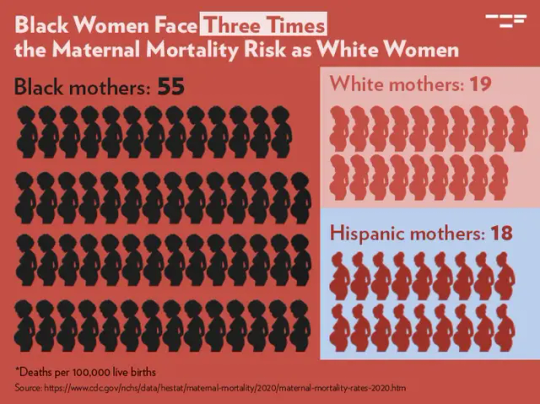
https://tcf.org/content/commentary/worsening-u-s-maternal-health-crisis-three-graphs/
Not only do black women face maternal disparities they also face disparities in gaining access to healthcare. Although Black women in the United States frequently face several formidable obstacles that negatively affect their well-being and exacerbate already-existing health disparities, access to healthcare is a fundamental right. Destroying systemic injustices and promoting a healthcare system that values inclusivity and equity requires an understanding of these obstacles. The barriers faced include financial constraints, many Black women encounter financial obstacles that impede their ability to obtain timely and comprehensive healthcare, such as high deductibles, out-of-pocket expenses, and lack of insurance coverage. There's also a lack of transportation as some may not have health care in their community and have to travel further. There are also personal barriers like mistrust in the healthcare system, sociocultural norms, and beliefs. Women struggling with these barriers may not get the treatment needed. For example, a lot of these barriers restrict black women from getting a mammography. This disparity has been shown in the United States breast cancer is the second most common cause of cancer mortality for black

https://www.ywcaworks.org/blogs/ywca/BIPOC-unequal-health-care
The history of institutional biases, systemic racism, and socioeconomic inequality are all intricately entwined with the crisis in Black women's healthcare in the United States. Black women continue to face obstacles and persistent health disparities, which can be attributed to a complex interplay of factors as reflected in this historical trajectory. Racial disparities were brought to light in the 1950’s-1970s, Civil Rights Movement in several societal domains, including healthcare. Despite the activism of Black women for their rights, healthcare inequalities continued because of barriers to care, differences in income, and prejudiced laws.
To promote a healthcare system that puts the health of this community first, immediate and coordinated action is required. The enduring disparities in healthcare access, systemic difficulties, and historical foundations highlight the urgent need for revolutionary change. Beyond just the numbers, there is a moral imperative to address this crisis to uphold justice, equity, and every Black woman's fundamental right to dignified healthcare.
sources:
https://digitalrepository.trincoll.edu/cgi/viewcontent.cgi?article=1072&=&context=trinitypapers&=&sei-redir=1&referer=https%253A%252F%252Fscholar.google.com%252Fscholar%253Fhl%253Den%2526as_sdt%253D0%25252C5%2526q%253Dcrisis%252Bof%252Bblack%252Bwomens%252Bhealthcare%2526btnG%253D#search=%22crisis%20black%20womens%20healthcare%22
https://www.bu.edu/articles/2023/racism-sexism-and-the-crisis-of-black-womens-health/
https://globalhealthsciences.ucsf.edu/blog/black-maternal-mortality-human-rights-crisis
https://journals.sagepub.com/doi/full/10.1177/1527154420965537
https://tcf.org/content/commentary/worsening-u-s-maternal-health-crisis-three-graphs/
https://www.ywcaworks.org/blogs/ywca/BIPOC-unequal-health-care
0 notes
Text
Intersectionality.. Understanding the pieces
By: Joshua Winters
I want you all to take a moment to think about your best friend. Imagine the qualities that make them THEM. The reasons they are your friend. I don’t know what you thought of, but I would bet that you mentioned the more qualitative or subjective qualities: their temperament, sense of humor, and character. I doubt you mentioned their height, their job, their race, or sexual identity. However, if you're looking for a potential mate, maybe height is a real factor for you. This is an ideal that is worth string for. Treating people for who they are as a person, not for social factors that we have assigned value to. Unfortunately, we don't live in an ideal world, and the qualities mentioned in the latter are meaningful factors that affect people's lives. The way to understand this is with the concept of intersectionality. Intersectionality is a term created by Kimberlé Crenshaw and it is used to describe how different forms of discrimination or oppression intersect and affect people's lives. It recognizes that modes of oppression are not mutually exclusive and that in order to rectify the issues of one mode of oppression we have to look at a multitude of factors.

lh7-us.googleusercontent.com
For example, imagine A woman named Jada, in a male-dominated field. The fact that Jada is a woman might affect the way in which she is treated by her colleagues. Now add that Jada is a Black woman, which adds another layer of complexity to the way in which she is treated. Say the problem we are trying to understand is why woman aren't progressing as far in their careers as their male counterparts. Simply looking at “women” as a data point would not give us enough information to understand the problem. In our example, Jada is also A black woman, meaning we need to understand the ways in which that identity affects her in the workplace. Age, sexual orientation, religion, marital status, and the list goes on, factors that influence people's lives.
Another way to conceptualize intersectionality is in terms of a puzzle. Each piece is different than another, but they all play a specific part in making up the whole picture. No one piece makes up the whole puzzle, and all the pieces get their value in relation to all the other pieces.
Attached below are additional resources to help explain intersectionality. The first is a TED talk from Kimberly Crenshaw herself explaining in more depth the concept and examples of how it shows in relation to police violence among male and female African Americans. The next is a quick video explaining what intersectionality is and can be used as a quick guide to explain the concept to people and get the conversation going. Since all of you are going to be graduating soon and going off to college I thought I would give one link to an opposing view of the issue. The article gives Coleman Hughes a critique of intersectionality which I think is important for you guys to learn to hear and evaluate all sides of an argument.
1.https://www.youtube.com/watch?v=akOe5-UsQ2o&ab_channel=TED
2.https://www.intersectionaljustice.org/what-is-intersectionality
3.https://quillette.com/2020/01/14/reflections-on-intersectionality/4
research links:
1.https://library.law.howard.edu/civilrightshistory/women/intersectionality#:~:text=The%20term%20intersectionality%20was%20first,complicate%20the%20various%20oppressions%20and
2.https://www.weforum.org/agenda/2020/07/diversity-inclusion-equality-intersectionality/
3.https://www.law.columbia.edu/news/archive/kimberle-crenshaw-intersectionality-more-two-decades-later
Blaze
0 notes
0 notes
Text
Want to hear love story it’s a love story?Its a story about a white man name, Richard Loving and a black woman named Mildred. It’s your classic love story boy meets girl boy fall in love with girl boy Mary’s girl. Richard and Mildred‘s love story had a lot of ups and downs because they were punished for being in love. So they sued the state of Virginia in the name of love . Now we have this supreme court case Loving v Virginia . Loving v. Virginia is a United States Supreme Court case that band making interracial marriages illegal. In order to understand this case, we have to understand what our constitutional rights are. Our constitutional rights are a list of rules and regulations that the government must stay in compliance with to protect citizens from abuse of power being manipulated by the government .
In this court case a white man and a black woman got married, and they were taken to jail for getting married . They were in love, but were told they could not marry each other in Virginia so they did with any lovebirds would do. They left and went where they could get married . They actually left the state of Virginia to get married in Washington DC. After getting married in DC, they went back to Virginia to continue to live their normal lives and they were punished for being a mixed race couple. So the Lovings went to the Supreme Court and argued that them getting in trouble for being black-and-white and married was a constitutional right violation . In the United States, anytime that there is a constitutional right violation, the case has a chance to be heard by the supreme court . After getting in trouble for simply being in love, the loving, fought for a chance to stay married, and to love who they want to love.
The Lovings argued that Virginia, as in the state of Virginia, violated their 14th amendment, right and the 14th amendment, right grants rights to all citizens, regardless of race, and it specifically limits the state of creating laws that limit the privileges of certain communities, lastly, it argues that each person have equal protection under the laws . Loving argued that Virginia violated their constitutional right to do process and equal protection. Virginia argued that they did not violate the right to due process or equal protection because both the black and the white spouse receives the same punishment and secondly, they argued that there was scientific evidence that proved interracial marriages could harm Virginia’s population. And the supreme court did not agree with Virginia.
The Supreme Court argued that there’s no reason to stop two individuals from getting married other than racial discrimination. The Supreme Court also argued that interracial marriages were only deemed illegal when involving a white person. The Supreme Court basically said what Virginia was doing was racism and was a way to try to maintain white supremacy . And the Supreme Court argued that the right to marry regardless of anyone’s race is a fundamental right granted by the due process clause of the 14th amendment and it’s needed for happiness by all free men . so let’s do a quick recap a black woman and white man got married the state of Virginia we’re upset, and they punished them. The lovings fought against the racial discrimination of the state of Virginia through a court case brought to the United States Supreme Court. The Supreme Court is the highest court in the land and love one. Do you like what I did there last name is loving I said, love won . And this supreme court case made interracial marriage legal and made it a constitutional rights violation for states to ban interracial marriage. This was such a huge court case and it gave freedom for people to love who they want to love no matter the race . And today’s day and age, we are still fighting for equal access to marry and to love who we want to love because at the end of the day, love wins all .
Sources: https://supreme.findlaw.com/supreme-court-insights/loving-v--virginia-case-summary.html#:~:text=Virginia%20had%20two%20primary%20arguments,Lovings%20received%20the%20same%20punishment.
https://www.oyez.org/cases/1966/395
https://www.archives.gov/milestone-documents/14th-amendment#:~:text=No%20State%20shall%20make%20or,equal%20protection%20of%20the%20laws.
https://www.law.cornell.edu/constitution/amendmentxiv
By shevah keller


0 notes
Text
The Power of Native American Protest Music
By Ithzy Lopez-Casiano
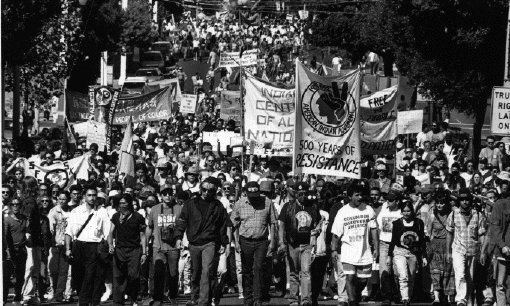
Native Americans have been the targets of genocide and hatred since the foundation of the United States of America. Music has always been an outlet for expression in every culture. What better way to combine the two and create music with a purpose- a purpose to speak up, fight back, and inspire. Protest music started gaining popularity around the late 1960s and 1970s. Some recognizable artists who made career-changing hits with their protest music are Bob Dylan, Creedence Clearwater Revival, and John Lennon. However, this post is not about any of these artists or their causes. Instead, this space is dedicated to focusing on the remarkable works of Indigenous musicians only and the impacts they continue to have on Indigenous issues.
A Little Bit of History...
The United States was founded upon corruption and the genocide of Indigenous peoples; therefore, there is systemic wrongdoing by the American government today. Protest songs emerge as a response to the need to protest. Since the rise in popularity of protest music in the mid-1960s, numerous reasons fueled this need for dissent. Indigenous history since the colonization has, unfortunately, been full of rage and tears, from events like Wounded Knee to the Red Power Movement to current environmental activism. Indigenous artists have found ways to express their anger towards American government and injustice. Here are some key events that inspired artists to speak up:
"The Rock" occupation-- The occupation of Alcatraz Island on November 4th, 1969, sparked the Red Power Movement, although it wasn't simply the sole cause of the entire movement. The 18-month occupation of "the Rock" was led by Bay Area Native American students and community members. The purpose was to draw attention to the promises the Johnson administration had neglected to fulfill. "The Proclamation of the Indians of All Tribes", proposed treaty stating,"We will purchase said Alcatraz Island for twenty-four dollars ($24) in glass beads and red cloth, a precedent sent by the white man's purchase of a similar island about 300 years ago." (The Alcatraz Proclamation: Annotated). The government ended the occupation by cutting electricity and basic resources to the island, forcing everyone to leave.
Environmental Justice Efforts-- Indigenous peoples are constant battles for the protection and preservation of their ancestral burial grounds and land resources. In 1990, Congress passed the Native American Graves Protection and Repatriation Act. Native Americans across the country advocate for the restoration of land and water resources, like the Kumeyaay tribe and Tohono O'odham tribe protesting against the boarder wall's impact on wildlife habitats, or the Standing Rock Sioux tribe protesting against the Dakota Access Pipeline.
youtube
Indigenous Musicians and Their Work
Let's delve into the heart of the matter. Who are Native American artists that make protest music and what does it sound like? I have created a Spotify playlist with some of the artists I've discovered and you can listen to it HERE.
As mentioned earlier, Native American issues have persisted for a long time, so the music varies in dates depending on the most relevant issues of the era. Here are some of the top impactful musicians that I have compiled:
In 1962 Peter LeFarge wrote "The Ballad of Ira Hayes," he was one of the first musicians that wrote music about Indigenous issues. This song recounts the story of Ira Hayes who was a Native American and Pima Marine who served in World War II. He was one of the six men in the iconic photograph who stood the American flag up in Iwo Jima. Despite being recognized as a war hero, Hayes faced discrimination and injustice upon returning home.

In 1969 the Native American rock and funk band Redbone was founded. Redbone became popular for their performances and music that heavily reflected their culture and traditions. Known for their top hit "Come And Get Your Love," they also produced their powerful protest song "We Were All Wounded at Wounded Knee" bringing awareness to the tragic 1890 massacre which killed about 300 people of the Lakota tribe.

Jimi Hendrix, of Cherokee and African descent, continues to be one of the most influential and iconic musicians of all time. He was well known for being antiwar and preforming live extended guitar riffs of his songs as political statements. His most notable antiwar songs include "Machine Gun" and his cover of "Star Spangled Banner" preformed at Woodstock in 1970.
Buffy Sainte-Marie is widely recognized for her protest music in the 1960s within the folk rock genre. She has been a dedicated activist for Indigenous rights and cultural preservation. Her activism extended to issues like Native American education and the treatment of Indigenous peoples. Some of her most impactful songs are "Universal Soldier" and "Now That The Buffalo's Gone."
Aztlan Underground, founded in 1989, gained traction with their 1995 album Decolonize, addressing social justice issues for Native Americans and indigenous Mexican-Americans. I personally love this album a lot because their sound is classic 90s hip hop and rock.
In more recent times, Raye Zaragoza has been releasing music centered around Native American issues. Her popular song "In The River" (2016) raises awareness of the Dakota Access Pipeline issue and its dangerous effects on the Standing Rock Sioux reservation's water supply.
The Importance of Protest Music
Buffy Sainte-Marie wrote an article titled "The Power of Protest Songs"(2013). She explains the importance of protest music and why it can be more significant and effective than any other written protest work.
"My 1963 song “Universal Soldier” impacted thousands of soldiers, students and families during the Vietnam war. It made a difference to the lives of people who are still thanking me 50 years later. On the other hand, along with “Now That the Buffalo’s Gone” and other Native American issue songs, it got me blacklisted by two political administrations and effectively silenced my voice in the United States, just when Native peoples most needed to be heard" (Sainte-Marie par 3).
What Sainte-Marie experienced reflects a pattern of history where artists who engage in activism, especially on controversial or challenging topics, may face backlash from authorities or institutions. Sainte-Marie's experience highlights the complex relationship between art, activism, and political repercussions. Despite the challenges, her enduring impact on those who were influenced by her music demonstrates the lasting power of art to inspire and provoke thought.
Sainte-Marie's philosophy on protest music is that it must contribute to a movement to help verbalize the raw emotions of the cause. Protest music is supposed to inspire others to act and fight!
According to Sainte-Marie, the ingredients to a good protest song are as follows: "brief, well-focused and catchy for the short attention spans of ordinary people" (Sainte-Marie, par 7). She describes protest songs as good journalism because they describe the moment in time they are written in, why emotions are so strong, and why the issue is important enough to be listened to.
Protest Music Is...
Native American protest music is a vital form of artistic and cultural expression that plays a significant role in advocacy, Indigenous empowerment, and strengthening social justice efforts. Yes, Native peoples have deep rooted traumas associated with the colonization of their land, but their musical resistance is a clear demonstration of healing and empowerment. I strongly encourage you to go and discover young artists singing about issues happening today, many of them are quite catchy!
Works Cited:
"AIM song." YouTube, uploaded by Aligtr8, https://youtu.be/RbORbJBEhBg. Accessed 10 January 2024.
CBC Music. "A Brief Evolution of Indigenous Protest Music." CBC, 19 March 2019, https://www.cbc.ca/music/read/a-brief-evolution-of-indigenous-protest-music-1.5062369. Accessed 10 January 2024.
CBC Music. "Singing in the Face of Colonial Danger: Music’s Place in Indigenous Resistance." CBC, 5 July 2023, https://www.cbc.ca/music/singing-in-the-face-of-colonial-danger-music-s-place-in-indigenous-resistance-1.6504559. Accessed 13 January 2024.
"Disaster at Wounded Knee." Library of Congress Classroom Mater. Library of Congress, https://www.loc.gov/classroom-materials/immigration/native-american/disaster-at-wounded-knee/. Accessed 13 January 2024.
Howard University School of Law Library. "Indigenous Self-Determination." Civil Rights and the Law, Howard University, https://library.law.howard.edu/civilrightshistory/indigenous/selfdetermination. Accessed 13 January 2024.
Sainte-Marie, Buffy. Smithsonian's National Museum of the American Indian. "The Power of Protest Songs." American Indian Magazine, https://www.americanindianmagazine.org/story/power-protest-songs. Accessed 10 January 2024.
The New Inquiry. "The Alcatraz Proclamation: Annotated." The New Inquiry, https://thenewinquiry.com/the-alcatraz-proclamation-annotated/. Accessed 17 January 2024.
1 note
·
View note
Text
Disparities in maternal health
By: Taylor Livingston
Disparities in maternal health means that there are differences in the health outcomes and experiences of pregnant people and new moms. These differences happen because of various factors like where you live, how much money you have, your race, and more. Some of the problems that can come up include not getting the right care when pregnant, higher chances of moms getting sick or even passing away, and overall health issues related to being a mom.
SocioEconomic Factors
Socioeconomic factors play a significant role in contributing to disparities in maternal health. Women with lower socioeconomic status may have problems with being able to get quality prenatal care in a timely manner. Many factors play a role such as having issues with having a way to get to and from doctors visit, not having health insurance or limited financial resources to pay for things that may not be covered by insurance. “Many women, especially those in rural or underserved areas, lack physical proximity to doctors or hospital maternity wards to receive pregnancy care or deliver a baby. Access to additional services, such as specialists, reproductive health care, and mental health care, can also be of concern. Even when physical access to needed providers and facilities is available, cost can often stand in the way for many women to receive necessary care.” Women in jobs with lower pay might find it hard to get enough time off when having a baby because they might not have access to maternity leave. This makes it challenging for them to take a break from work before and after giving birth. Financing for food also impacts maternal health whether the women can buy healthy food. Not having enough resources might mean she doesn't get the right nutrition during pregnancy, which can be bad for both her and the baby's health.
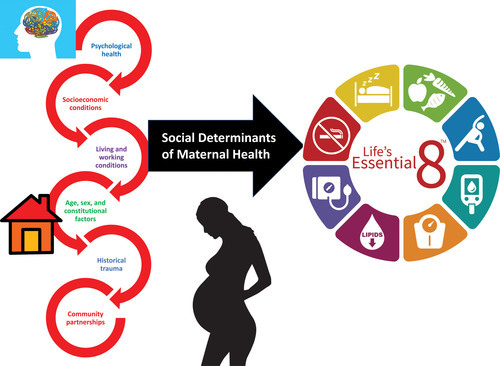
Race and Ethnicity
A woman's race and ethnicity can affect how she is treated during pregnancy. Unfortunately, some groups may face more risks, receive less attention in medical care, and have worse outcomes for both the mother and the baby. This is a problem that needs attention to ensure all women, no matter their race or ethnicity, receive the best care during pregnancy. Sometimes, in healthcare, people might be treated differently based on their race or ethnicity because of unconscious biases. This can create gaps in how well patients are cared for. For example, studies have found that women from minority racial and ethnic backgrounds may not receive the same level of care as white women, affecting their health during pregnancy and overall well-being. “In fact, Non-Hispanic black women have the highest rates for 22 of 25 severe morbidity indicators used by the Center for Disease Control (CDC) to monitor population estimates for severe maternal morbidity.” Healthcare systems need to understand and respect different cultures to provide good care for diverse groups of people. Being culturally competent, which means understanding cultural practices and beliefs, is crucial for offering the right and respectful healthcare.
Below I provide a variety of links that talk more on this issue if you were interested:
https://journals.lww.com/greenjournal/citation/2015/03000/racial_and_ethnic_disparities_in_maternal.24.aspx
Eliminating Racial Disparities in Maternal and Infant Mortality - Center for American Progress
Racial justice in maternal health: How to reduce Black maternal mortality - UChicago Medicine
Sources:
Reducing Disparities in Severe Maternal Morbidity and Mortality - PMC
Racial Disparities in Maternal and Infant Health: Current Status and Efforts to Address Them | KFF
The Health Care System and Racial Disparities in Maternal Mortality - Center for American Progress
0 notes
Text
Manilatown
By Sabrina Pepito
The Bay Area was much different than it currently is today. Manilatown was once at the edge of what is modern time’s Chinatown in San Francisco, and home to many migrants from the Philippines and China. The International Hotel was a significant part to the people of Manilatown, but the closure of it led to the erasure of this community. With this post, we’ll discover what happened to this San Francisco neighborhood, and what’s remaining of it.
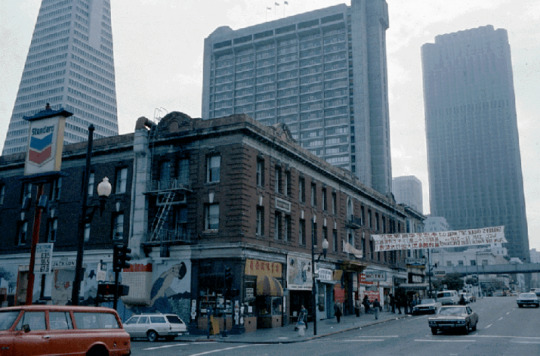
The Forgotten Neighborhood

The majority of immigrants from Asia were from China and Japan, but after backlash and racism occurred, people coming from those countries were barred. The U.S. turned to the Philippines (which was once colonized by them until 1946), as well as Mexico, for labor with low wages. At least 30,000 Filipinos had settled in where Manilatown was when coming for work, partially due to the fact that they could not afford to live anywhere else. Before, San Francisco had been racially segregated, and white communities had shut out anyone different from them from living in areas nearby. This, however, did not stop the Filipino people from creating a home, as well as a town with small businesses and other living necessities around them. It was said that many Filipino people got along with those from Chinatown as well, as they could relate to being in a foreign country where they were not appreciated. Outside of their neighborhoods were “white vigilante groups” who tried to lure people out from Manila or Chinatown, and brutally beat or kill them out of pure spite. Manilatown became a place of safety for immigrants, especially the International Hotel.
Check out this video for more details!
youtube
The Importance of the I-Hotel
“The International Hotel became a symbol for an entire minority community” (Manilatown Heritage Foundation)
The International Hotel (also known as the I-Hotel) was home to Filipino and Chinese families, workers, and elderly. It was not the best living space, however it was what was available for these people at an affordable price. As mentioned earlier, people could live safely in the security of others with similar cultures to them.
Unfortunately, it was not home forever. At around 3:00 AM on August 4th, 1977, nearly all of the tenants (around 150) were forcibly evicted from their homes. Prior to this, urban renewal was occurring throughout parts of San Francisco. For instance, the Black people of the Fillmore District were removed under the guise of “redevelopment”. This large community, similar to the situation those in Manilatown went to, had dwindled.
Starting in 1968, the talks of urban renewal and tearing down buildings to remake San Francisco had begun, and people of all kinds united under a movement in an effort to stop this. The I-Hotel was a part of this “eviction battle”, as over 3,000 people from this community stood together as a nonviolent human barricade around the building. They protected the building with their lives, against a group of 400 riot police. In the end, the government had taken over the building and evicted all the remaining people inside. No efforts were put into relocating the Filipino and Chinese people, and many had either found other residential homes nearby or were forced to leave the city. This led to the end of Manilatown, a community that was built up as a place of safety for immigrants, and the country they worked for demolished it.

The Legacy Left Behind
Today, the residential hotel has been remade in its original location in what is now Chinatown. It’s now a fifteen story senior living home, complete with a parking lot underneath it. It had been an empty lot since the first I-Hotel had been torn down, but over 20 years later and lots of discussions between activists and residents in Chinatown, it was once again created as a place for people to call “home”. Instead of the high-rise office building planned out by the developers who had bought out the lot, the community rose to keep what once existed as a memory to some in the area.
Manilatown technically no longer exists, but the International Hotel is now run by the Manilatown Heritage Foundation. This organization has been working to restore and preserve the culture and history left behind from the unfortunate events that affected the community. As of now, they are working to turn a portion of the hotel into a community cultural center for gatherings between Asian Americans and others home to that portion of the Bay Area. The San Francisco neighborhood never fully disappeared, even if the main building was torn down. You could take away the homes and lives from people, but never their history or sense of community.
Visit the official websites!
Sources
Chinatown Community Development Center. “International Hotel Senior Housing.” Chinatown Community Development Center, https://www.chinatowncdc.org/our-portfolio/international-hotel-senior-housing.
"How San Francisco erased a neighborhood" YouTube, uploaded by Vox, 10 March 2020, https://www.youtube.com/watch?v=tcsdglJFT0M.
IHSHI. “History.” The I-Hotel - San Francisco, https://www.ihotel-sf.org/history/.
Lurie, Gabrielle. “A community lost, a movement born: International Hotel evictions still shaping S.F. 40 years later.” San Francisco Chronicle Interactives, 11 August 2017, https://projects.sfchronicle.com/2017/international-hotel/.
Manilatown Heritage Foundation. “History.” Manilatown Heritage Foundation, https://manilatown.org/about-us/history/.
Santina, Don. “Ethnic Cleansing in San Francisco.” FoundSF, https://www.foundsf.org/index.php?title=Ethnic_Cleansing_in_San_Francisco.
0 notes
Text
Black Infant and Maternal Mortality Rates
Madison Sherwood

The health crisis in the Black Community acts as a non-negotiable proof of racial disparity, and while it is important to address this social dilemma in it’s entirety, I will be acknowledging one specific concern: Black infant and maternal mortality rates. Being a student in pursuit of a career as an Obstetrician Gynecologist (more popularly referred to as an ObGyn, a women’s health doctor who specializes in reproduction, pregnancy, and labor and delivery) this is a topic I am incredibly passionate about.

My primary source of inspiration whilst researching for this post originated from a novel written by American author and journalist Linda Villarosa. Her text titled “Under the Skin: The Hidden Toll of Racism on American Lives and on the Health of our Nation” examined in great detail the effects that race has on Black mothers and babies alike. She explores the claim that it is not the commonly blamed educational or economic status of impoverished Black individuals that causes these health concerns (this is proven by credible evidence sourced from The Center for Disease Control aka the CDC in 2023 which stated that “PRMRs [pregnancy-related mortality ratios] for black women with at least some college education were higher than those for all other racial/ethnic groups with less than a high school diploma”), nor is it simply biological, but rather that racism is the perpetrator- not race. She refers to the physical effects that racism has on health with the term “weathering” which Villarosa defines as “high effort coping from fighting against racism [which] leads to chronic stress that can trigger premature aging and poor health outcomes”(Villarosa 80). She notes how stress triggers the brain to release adrenaline and cortisol hormones, then simultaneously raises an individual's blood pressure and heart rate, leading to negative impacts on one’s overall wellness.
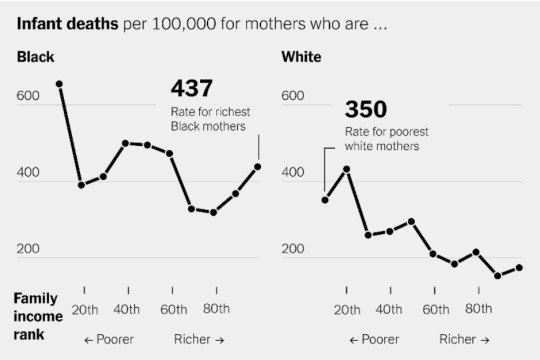
(A chart depicting a lack of correlation between economic status and mortality rates, as previously mentioned above. Read this article by the NY Times for more information: https://www.nytimes.com/interactive/2023/02/12/upshot/child-maternal-mortality-rich-poor.html)
So what does this mean for the mothers and babies? Weathering has negative impacts on the health of an average Black individual, but for a pregnant woman this phenomenon is detrimental to both her and her child. The hormones noted above that raise a person’s blood pressure can cause Preeclampsia in pregnant women. This is “persistent high blood pressure that develops during pregnancy […] and is often associated with high levels of protein in the urine OR the new development of decreased blood platelets, trouble with the kidneys or liver, fluid in the lungs, or signs of brain trouble such as seizures and/or visual disturbances.”(Preeclampsia Foundation 2023). If the condition is too severe or left untreated and becomes Eclampsia it is fatal for the fetus and potentially the mother as well. Chronic stress can also contribute to fatigue and malnourishment, oftentimes the cause of uncommonly low birth weights amongst Black infants regardless of the status of their mother. Therefore, weathering as a response to racism is the reason that “Black women in the United States (U.S.) disproportionately experience adverse pregnancy outcomes, including maternal mortality, compared to women of other racial and ethnic groups.”(The National Library of Medicine).

(This graph from the CDC acts as evidence considering viewers can note the drastic difference in deaths per live birth between Non-Hispanic Blacks and women of other ethnicities. Click here to read the brief accompanying article which provides more statistical data: https://www.cdc.gov/nchs/data/hestat/maternal-mortality/2021/maternal-mortality-rates-2021.htm)

Villarosa provided several testimonies from real women within her novel as proof of her claim. These Black women spanned across all social classes, economic statuses, and ages- yet were all unified through their shared narratives involving pregnancy and healthcare in our country. She included stories from a woman who immigrated here to the United States from Haiti, a woman who is a highly educated doctor and former athlete, a single mother of three living in poverty, and even referenced herself and her own pregnancy. While each story varied, they all shared the effects that racism and it’s associated chronic stress had on their experiences. One woman lost her baby due to Eclampsia, another experienced a life threatening labor and delivery, while yet another birthed an infant with a low birth weight. Villarosa, a Black woman, notes that her daughter was also much too small when she was born. Because of this healthcare providers, and future healthcare providers such as myself, need to be vigilant with advocating for their Black patients as well as educating themselves regarding the role of weathering within the Black community. Extra preventative measures must be taken as it is proven that the effects of racism are directly linked with Black infant and maternal mortality rates. According to the the US Department of Health & Human Services “In 2020, non-Hispanic black/African American mothers were twice as likely to receive late or no prenatal care as compared to non-Hispanic white mothers.”, this cannot be accepted as the norm.

Still interested in learning more? Watch this short video by PBS! It does a great job at briefly summarizing racism’s impact on infant and maternal mortality.
Sources:
“Infant Mortality and African Americans.” Office of Minority Health, minorityhealth.hhs.gov/infant-mortality-and-african-americans#:~:text=Non%2DHispanic%20black%2FAfrican%20American%20infants%20had%202.9%20times%20the,to%20non%2DHispanic%20white%20mothers. Accessed 18 Jan. 2024.
Kliff, Sarah, et al. “Childbirth Is Deadlier for Black Families Even When They’re Rich, Expansive Study Finds.” The New York Times, The New York Times, 12 Feb. 2023, www.nytimes.com/interactive/2023/02/12/upshot/child-maternal-mortality-rich-poor.html.
Krisberg, Kim. “Programs Work from within to Prevent Black Maternal Deaths: Workers Targeting Root Cause - Racism.” The Nation’s Health, American Public Health Association, 1 Aug. 2019, www.thenationshealth.org/content/49/6/1.3-0.
“Linda Villarosa Is the 2023 Viewpoints on Health Speaker.” JMU, 16 Feb. 2023, www.jmu.edu/news/chbs/2023/02-16-viewpoints-on-health-villarosa.shtml.
“Maternal Mortality Rates in the United States, 2021.” Centers for Disease Control and Prevention, Centers for Disease Control and Prevention, 16 Mar. 2023, www.cdc.gov/nchs/data/hestat/maternal-mortality/2021/maternal-mortality-rates-2021.htm.
Njoku A, Evans M, Nimo-Sefah L, Bailey J. Listen to the Whispers before They Become Screams: Addressing Black Maternal Morbidity and Mortality in the United States. Healthcare (Basel). 2023 Feb 3;11(3):438. doi: 10.3390/healthcare11030438. PMID: 36767014; PMCID: PMC9914526.
“Preeclampsia - What Is Preeclampsia.” Preeclampsia Foundation - Saving Mothers and Babies from Preeclampsia, www.preeclampsia.org/what-is-preeclampsia. Accessed 18 Jan. 2024.
“Racial/Ethnic Disparities in Pregnancy-Related Deaths - United States, 2007–2016.” Centers for Disease Control and Prevention, Centers for Disease Control and Prevention, 5 Sept. 2019, www.cdc.gov/mmwr/volumes/68/wr/mm6835a3.htm.
“Strengthening Black Maternal Health.” MCHB, mchb.hrsa.gov/programs-impact/focus-areas/maternal-health/black-maternal-health. Accessed 18 Jan. 2024.
“WKAR Specials.” PBS, Public Broadcasting Service, 10 Feb. 2022, www.pbs.org/video/twice-as-likely-black-infant-mortality-rates-in-the-us-qmag9i/.
0 notes
Text
The Silent Struggles of Asian American Women
By: Emily Diamante
Intro
Intersectionality is when two social identities intersect, making unique situations for an individual. Women in America are faced with various difficulties ranging from the wage gap to sexual harassment. Asians in America experience discrimination, stereotyping, etc. Asian American women in this country experience all of these dangers simultaneously. My name is Emily Diamante and this blog post will briefly cover examples in history where Asian women were stereotyped and discriminated against for being both a woman and Asian.
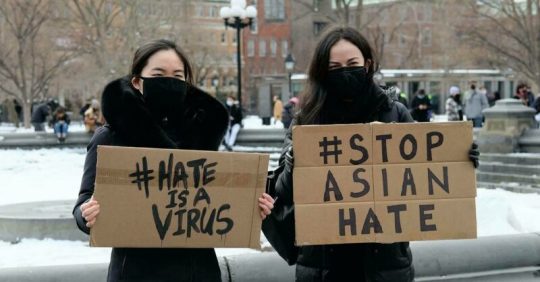
Starting from the Beginning
In 1875, the Page Act was passed. This act restricted Asian women from immigrating to the U.S for prositutional purposes. This was one of the first instances of heavy stereotyping on Asian women. With the passing of this act, this wrongly profiles Asian women as prostitutes, dehumanizing them to an object. In addition, this act prevented Asian couples from starting families. It is important to note that the fourteenth amendment states, “all persons born or naturalized in the United States”. So due to the Page Act, the exclusion of Asian women in the country prevented these couples from starting a family. This stereotype was further portrayed when it came to the idea of a “military man”. The identity of a military man was just this macho, super masculine guy. So masculine that being called anything related to feminists was considered an insult. The stereotypical Asian woman at that time is the perfect opposite of a military man. Asian women are seen as submissive, seductive, only capable of serving men.
Covid
With the COVID-19 pandemic, harmful acts of hate towards the Asian community has increased by 339% in some of the largest cities in the U.S. It is clear it is because of people’s fear, scapegoating, and misinformation that caused Asian hate to grow so much in such a short amount of time. It is also no coincidence that when President Donald Trump used phrases such as “Kung- Flu” or “China Virus” that the blame on Asian Americans got even worse. The AAPI have documented about 4,000 instances of hate with Asian women being targeted 2.3 times more than men. Asian American women have stated that they have experienced some of these situations: being called racial slurs, comments about racial stereotypes, being followed via car, accused of being dirty, and being accused of having the “China Virus”. Because of these experiences, it is no doubt that Asian Americans have felt hopeless and frustrated during this pandemic. They are disappointed with the American government for how they are being treated. Asian women fear their treatment so much to go as far as to shop in only Asian stores.

Atlanta Shooting
March 16, 2021. Robert Aaron Long attacks a massage parlor and two spas in Atlanta, Georgia. He shoots and kills eight people. All eight victims were Asian women. This tragic, targeted attack was a symbol that highlighted the intersection of racism and sexism. This act of violence represented the ongoing struggles of the objectification, fetishization, and dehumanizing experience of Asian women in America. This attack sheds light on urgent issues that need to be addressed.
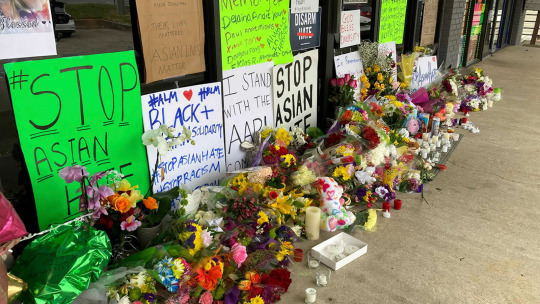
Below I provide a variety of links that talk more on this issue if you were interested:
https://www.apa.org/pubs/highlights/spotlight/issue-119
https://www.frontiersin.org/articles/10.3389/fpubh.2023.993396/full
https://www.asianwomenunited.org/
Works Cited
Lang, Cady, and Paulina Cachero. “How History Puts Asian Women in America at Risk.” Time, Time, 7 Apr. 2021, time.com/5952819/history-anti-asian-racism-misogyny/.
“Prof. Hahm & Colleagues Share First-Hand Experiences of Asian American Women Survivors of Discrimination during COVID-19.” School of Social Work Prof Hahm Colleagues Share FirstHand Experiences of Asian American Women Survivors of Discrimination During COVID19 Comments, 1 Oct. 1969, www.bu.edu/ssw/prof-hahm-colleagues-share-first-hand-experiences-asian-american-women-survivors-discrimination-during-covid-19/.
Where Sexism and Racism Meet: The Danger of Existing as an Asian ..., www.law.georgetown.edu/gender-journal/wp-content/uploads/sites/20/2022/03/I.-Oishi_Where-racism-and-sexism-meet.pdf. Accessed 19 Jan. 2024.
2 notes
·
View notes
Text
How Ethnic Studies Came to America
By: Matthew Moses
Ethnic Studies has been fought for over the last 50 years, spanning all the way back to the great Martin Luther King Jr. The journey that ethnic studies took in order for it to get to America and be studied is quite incredible. After all, it’s the whole reason we’re even in this class to begin with.
The ethnic studies journey began in the 1960’s with many different movements, but in particular we all remember the Civil Rights movement (not actually remembering the days but it's what stands out to everyone). MLK leading the way along with Malcom X and many others, they wanted to put an end to segregation and move into equality. This is where ethnic studies start to creep its way into the conversations.
The Latest Resurgence of Ethnic Studies | History News Network
In 1968, the longest strike in U.S. history occurred at San Francisco State. The Black Student Union (BSU) along with the Third World Liberation Front (TWLF) went on strike for 5 whole months, wanting equality in the school. They wanted a “whites” education as they got the top tier learning experience. They also wanted more teachers of color and a new system/class that would share the history of other cultures and what people went through. This monumental strike provided us with the first ever BSU, a Latin American organization and many more ethnic groups.
youtube
Next in line we see the TWLF again with their list of demands to end the strike and put everyone back in class. The TWLF designed this list to better the ethnic groups at schools and acknowledge that something is wrong, those groups aren’t being recognized. The lists consist of many ideas, main ones being 50 faculty positions open up for teachers of color and all ethnic students who applied will be accepted. Also, they wanted a new course that involved the study of ethnic culture and their backgrounds. These ideas got to the school and were put into effect immediately the following semester.

For nearly 2 decades after the list of demands was put out by the TWLF, the U.S. economy went under which stopped the production of those ethnic studies classes. With a faulter like this, who knows where we could be now with the development of ethnic studies stopping for like 20 years.
A huge development came through in 1998 with Tucson Unified School District. They were the first district in the U.S. to offer a Mexican American studies class. This was a big step, recognition in the Mexican American community was exactly what the growth of ethnic studies needed going forward. However, an unfortunate bill passed in 2011 where that exact program would be exterminated and no longer available for those students. The reason was that it was advocating for ethnic solidarity instead of the treatment of people as themselves. A big setback was not written in the books for the ethnic studies programs, but that never stopped it from perseverance.

The ban didn’t last long on schools as in 2014 El Rancho Unified School District became the first system to require students to pass the ethnic studies course offered to them. Graduation was determined on this course, that’s one way to get a point across!
Finally, where we are today with ethnic studies is because of this. Governor Jerry Brown signed a bill that requires schools to have ethnic studies classes, creating a guide to get it done. And in 2021, Gavin Newsome signed a legislation that requires all high school students to pass an ethnics studies course to graduate. At long last, ethnic studies has made its way into all of our lives, and who isn’t grateful for that.
Want more information? Here's a link to a timeline of the events leading ethnic studies to America.
Sources:
The Oil Shocks of the 1970s – Energy History (yale.edu) - U.S. economy paragraph
History of Ethnic Studies Timeline – Ethnic Studies K-12 – XChange – UCLA Center X - timeline for more info
California becomes first state to require ethnic studies in high school | EdSource - signing of legislation
1 note
·
View note
Text
Environmental Justice: The Modern Struggles of Native Americans
By Aidan Sauer

You may have learned in school about the history of Native Americans, the pre-Colombian period, contact with Europeans, the colonial period, and westward expansion, among other things. Typically, these are common things taught in schools in order to give students a general background regarding the history of the Native peoples. However, the history that is covered surrounding Native Americans usually goes up to the beginning of World War 1. After this point, it seems as if Native Americans are forgotten. But their history did not stop there. Many events occurred throughout the 1900s and to the modern day, which I think are important to discuss and learn about in a classroom setting.
Here is a source to learn more about Native Peoples' modern struggles
One thing that resonates with everyone after learning about Native Americans is the fact that they were displaced by colonizers and had their land taken from them. Some efforts were made to restore land and give reparations to Natives in the 1900s, but not enough has been done. A modern concept that goes hand in hand with the issues that Natives face is Environmental Justice. This topic is covered in Ethnic Studies courses in many different CSUs and teaches students how different ethnic groups are affected by their environment. As defined by the EPA, environmental justice is “the fair treatment and meaningful involvement of all people regardless of race, color, national origin, or income, with respect to the development, implementation, and enforcement of environmental laws, regulations, and policies.” For Native Americans, environmental justice has many different meanings. Some of these include
Protecting lands that are sacred and or required by Indigenous communities in order to be healthy
Upholding and creating treaties that allow Indigenous communities access to natural resources
Empowering Indigenous communities in advocating for their environmental rights and providing them with the tools to participate in decision-making processes
For more information about Environmental Justice for Native Americans, visit the website below
Since colonizers came to America, there has been pushback from Indigenous Peoples attempting to retain not only the land, but also the culture that belonged to them. A modern example of pushback was the Trail of Broken Treaties protest of 1972.

This protest began as a caravan consisting of many Native Americans from different tribes and regions in California and Washington, the group being called the American Indian Movement (AIM). Their goal was to create a manifesto that consisted of various demands to be fulfilled by the U.S. under the presidency of Richard Nixon, to whom they planned to hand the manifesto personally. The manifesto contained 20 demands, each strongly related to environmental justice. They created their manifesto in St. Paul, Minnesota, and when they finally arrived in Washington, D.C., Nixon was not there. This caused them to seek answers from the Bureau of Indian Affairs (BIA) office, which escalated to AIM taking control of the building for a week. Eventually, an agreement was reached, but the manifesto was rejected. However, in the years to follow, Nixon used various key parts of the manifesto when creating the Self-Determination Policy. This was a step in the right direction for Native Americans in more recent times.
Here’s an informative website that covers the Trail of Broken Treaties protest
Still today, Native Americans need environmental justice. They continue to face problems that affect the environment that they live in. Things like “water contamination, dumping, air pollution, mining waste, and climate change,” (Native American Rights Fund), all affect different tribal nations. It is important to be aware of this so that when a bill that would potentially harm Native Americans is being passed, you are aware of their circumstances and can make a decision based on your knowledge. Their environment gives them strength, healing, and a sense of purpose. “As Winona LaDuke has argued, the survival of native nations is directly linked to their sustainable interaction with the land, and with the practices, ceremonies, and beliefs tied to that place,” (Schlosberg, Carruthers).
Works Cited
EPA. “Environmental Justice.” EPA, Environmental Protection Agency, 2024, www.epa.gov/environmentaljustice.
“Issues - Native American Rights Fund.” Native American Rights Fund, 30 July 2022, narf.org/issues/#:~:text=Many%20Native%20Americans%20face%20risks,to%20govern%20their%20territory’s%20environment.
Schlosberg, David, and David Carruthers. “Indigenous struggles, environmental justice, and community capabilities.” Global Environmental Politics, vol. 10, no. 4, 2010, pp. 12–35, https://doi.org/10.1162/glep_a_00029.
0 notes
Text
A Brief History of the Racist Crack Cocaine Sentencing Disparities in the United States

By Dakota Coon.
You’ve probably been told not to do drugs at some point in your life. Most of us carry a heavy negative association with people who use illicit drugs - but have you ever considered why general society has such a distaste for drug users? Why are some drugs illegal while others aren't?
The point of this article is not to minimize the pain related to drug use, I’ve known people who have passed away due to an overdose. I am deeply familiar with the pain of watching a loved one addiction consume them. But I also know people who use drugs aren't just like us, they are us. They’re our friends, our family, our coworkers, our loved ones, and our community members.
I want to explore a history of legality, mandatory minimums, and the real impacts written laws can have on massive populations of people. Especially black Americans.
Most of the laws in the United States regarding drug sentencing are not backed by any scientific or legal reasoning.
Drugs are not made legally equal, but some are made chemically equal! Perhaps you’ve heard of the drugs “crack” and “cocaine”. In reality, crack and cocaine are the same exact drug. Crack is a byproduct created by synthesizing powder cocaine. Chemically they are identical. Despite crack cocaine and powder cocaine being THE SAME THING, from 1984-2010, under the ‘Anti-Drug Abuse Act of 1986’, there was a 100:1 sentencing disparity between crack cocaine and powder cocaine.
As summarized by the ACLU in 2006, “distribution of just 5 grams of crack carries a minimum 5-year federal prison sentence, while for powder cocaine, distribution of 500 grams … carries the same sentence.”
Now what was the root cause of this disparity? Well, remember that anti-drug campaign that would come to our elementary schools, DARE - Drugs Are Really Expensive?
What's that? That wasn't the name? Anyway-
The basics are that powder cocaine costs significantly more than crack cocaine. This means more impoverished black and brown people have access to crack, and more privileged white people have access to powder cocaine. Even within crack cocaine users, black offenders are FAR more likely to be convicted than white offenders, as demonstrated in the table below.

These racist sentencing disparities had a devastating impact on black communities. In 2000, there were more black men in prison than black men in higher education. From 1986-2005, the rate of black women in prison increased by more than 800%, compared to a 400% for women overall. (ACLU)
There was no reason given by Congress for the 100:1 disparity, and no evidence presented in court to deem it necessary. Crack cocaine is not more dangerous than powder cocaine in any way. Crack is not more addictive than cocaine. Crack does not make people act more violent than cocaine. Crack babies are not real, and crack is not instantly addictive. These claims have been proven time and time again to be scientifically false.
Hundreds of thousands of people's lives were irreversibly damaged by inherently racist drug sentencing laws, that Congress has yet to admit fault or enact any reparations.

In 2010, after years of fighting, advocating, and educating on the part of the ACLU, FAMM, the United States Sentencing Commission, and numerous other organizations and people - congress passed the Fair Sentencing Act. The FSA reduced the ratio from 100:1 to 18:1; and introduced the possibility of people sentenced under the former crack cocaine laws to be seen before a federal judge to reduce their sentences.
This is a step forward, but as stated by the ACLU, still a compromise. Once again, crack cocaine and powder cocaine are identical, they should have identical sentencing guidelines. I would argue anybody who was imprisoned under the 100:1 ratio should have been released and paid damages, but that would never happen. That would require the United States Government to admit it made a grave mistake.
Laws can be inherently flawed and can be a tool of racial oppression. There is no such thing as a law that is not tainted by bias, as bias is inherent to humanity, and last time I checked, humans are the ones writing legislature.
Question why certain drugs are sentenced harsher than others. Question why laws are written in ways to purposefully pursue and exclude groups of people. Question the choices your government makes, and why they make those choices. This is necessary for liberation.
Suggested Further Reading:
A great jumping-off point is “Smoke and Mirrors: The War on Drugs and the Politics of Failure” by Dan Baum. Buam interviews numerous people involved in the war on drugs to discuss its utter failure: exploring how the war on drugs led to more drug use, more convictions, and more drug-related deaths.
Another great resource is harmreduction.org. The harm reduction coalition's website does a better job explaining harm reduction practices than I ever could in a blog post.
I especially recommend their harm reduction resources near you section, if you or anybody you know need clean needles, fentanyl testing strips, or free naloxone.
Sources, In Vauge Order of Relevance:
Cracks in the System - 20 Years of the Unjust Federal Crack Cocaine LawDorsey Vs The United States of America
ACLU Brief of the Fair Sentencing Act
Dr. Carl Hart's "No More Crack Powder Disparities"
The Case Against Mandatory Minimum Sentences
United States Sentencing Commission's Report on the Effects of the Fair Sentencing Act
0 notes
Text
Intolerance and Discrimination Towards Religious Communities
By: Matthew Bachelier
The United States of America is best known as a “melting pot” because of the diversity present throughout the country whether it be race, ethnicity, religion, and more. According to the 2020 U.S. census, about seventeen different types of religions are present and practiced in America. Twenty-three percent of the population is unaffiliated and is the majority of the population, but the largest religion present in the U.S. is White mainline protestant making up sixteen percent of the population.

So with that being said, are people of a minority religion faced with intolerance or discrimination? A group that experiences hardships often is the Jewish community. The Jewish community makes up about one percent of the population in the U.S. I would argue that Jews can fit into the Model Minority category as many stereotypes have been made about how they are financially successful. Many assumptions are made about the Jewish community being wealthy and in control of economic institutions, which is an oversimplification of who they are as a whole. Another Challenge faced by the Jewish Community is that Anti-semitism is still present in the U.S. and this can often lead to hate crimes targeted at their community. According to ABC News on October 28, 2018, a man by the name of Robert Bowers walked into a Pittsburg Synagogue and shot and killed 11 worshipers. These acts of antisemitism in the U.S. create a negative impact on the Jewish communities day to day lives and a narrative that they are not welcome or wanted in the U.S. The Jewish community has resorted to hiring full-time bodyguards to help protect the people attending the synagogue and the synagogue itself, they are simply trying to worship their God and follow their faith.
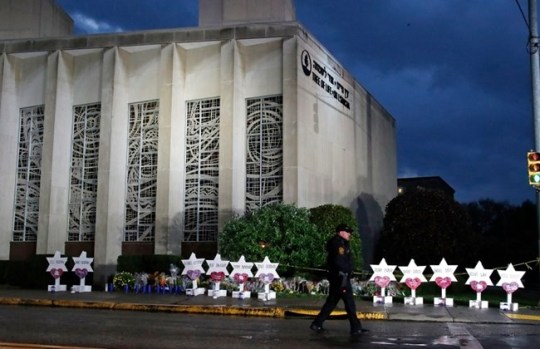
Another community and religion in the U.S. that very often experiences intolerance or discrimination is the Muslim faith. After the horrific acts that occurred on September 11, 2001, the Muslim community has been seen as nothing but a threat in the U.S. According to the New York Times and a study conducted at the California State University, San Bernardino in 2015, hate crimes against the American Muslims were up seventy-eight percent. People of the Muslim community face constant adversity when leaving their homes when wearing traditional Muslim or Middle Eastern attire. Muslims are seen as a threat and dangerous everywhere they go especially in airports. Less than three percent of passengers receive a pat down or secondary screen when going through security at the airport, meanwhile, thirty-six percent of Muslim Americans have to go through a pat down or secondary screening. If this statistic does not demonstrate the stereotypes created about the Muslim community being a constant threat to the Security of the U.S., I am not sure what will. The point here is being different and a minority of any kind means many will jump to conclusions about you or accept stereotypes that have been created whether they are good or bad.
Sources:
“PRRI Census of American Religion: 2020.” PRRI, 16 Jan. 2024, www.prri.org/research/2020-census-of-american-religion/.
ABC News, ABC News Network, abcnews.go.com/US/pittsburgh-synagogue-mass-shooting-jury-reaches-verdict-death/story?id=101220141. Accessed 18 Jan. 2024.
Lichtblau, Eric. “Hate Crimes against American Muslims Most since Post-9/11 Era.” The New York Times, The New York Times, 17 Sept. 2016, www.nytimes.com/2016/09/18/us/politics/hate-crimes-american-muslims-rise.html.
More Sources:
0 notes
Text
Racism in the Makeup Industry
by Henry Muentz
Shade Ranges
Beauty brands often don’t cater to darker skin tones when it comes to their shade ranges. While this issue applies to all types of products, the obvious example for this is foundations. It’s important to have a shade that matches your skin’s depth and undertone, but for many people with dark skin this isn’t so easy. There may be 20 or so shades for light-medium skin tones, and then 3 or 4 for deep. Not only does it not go dark enough, but the jumps between shades are massive. Take a look at this shade range from Tarte, one of the biggest makeup companies in the industry.

Tarte Shape Tape Foundation Shade Range
It’s obvious that there are not nearly enough shades in this line. While lighter skin tones could probably find a shade to work, dark and even medium skin tones would most likely not be able to find their shade. There isn’t even a shade that matches this model’s arm.
Over the past few years, beauty consumers have been pushing for more inclusive shade ranges. This was largely sparked by Fenty Beauty, Rihanna’s brand, launching a 40-shade foundation line that was inclusive of all skin tones.
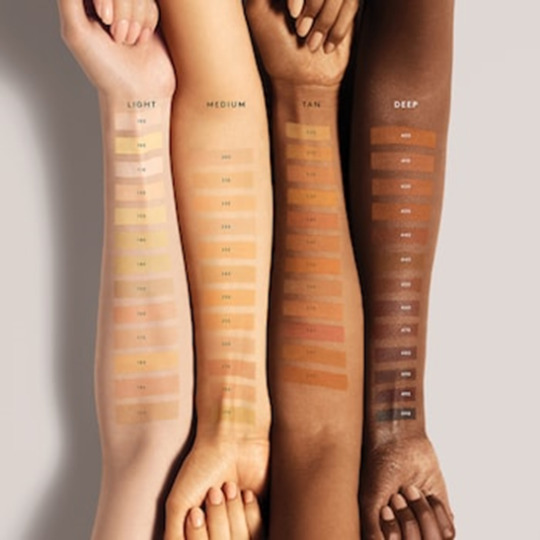
Fenty Beauty Soft Matte Foundation Shade Range
Comparing this shade range to Tarte’s, we see how much more the shades could have been developed. Fenty’s launch also demonstrated how there is very much a market for higher end products that cater to darker skin. Lack of shade range is a major way that people of color have been restricted from the beauty industry. The idea behind this exclusion is that people of color wouldn’t have to money to spend on expensive makeup products, but this is obviously not the case. If you want to learn more about the development of makeup products for people of color, specifically black women, the article below is a great resource.
Makeup Artists
Different skin tones require different products and techniques; however, many makeup artists aren’t trained with this in mind. In the modern day, you would think all makeup artists would be aware of this. Professionals should have a kit filled with all sorts of shades and products to cater to ALL skin tones, but this just isn’t the case a lot of the time. One example of this is model Megan Milan. She posted about her experience as a model for New York Fashion Week, one of the biggest fashion events in the world. She assumed that in such a professional and high visibility campaign the makeup artist would be a skilled professional. When the makeup was done though, she said, “I look like a ghost”. While this is just one example, thousands of women must deal with this issue. The artist paints them too light or too dark, the undertones are wrong, the blush is ashy, the contour isn’t dark enough, etc. For some more info on this, the article below has some personal stories from black celebrities.
I’m not a makeup artist, but I have personal experience with issues like this. I work at a makeup store and got almost no training on matching products with different skin tones than mine. How am I supposed to give accurate shade recommendations if I have no experience? I shouldn’t have to experiment with customers and use them as my training. It leads to customers getting incorrect shade matches and being unsatisfied. This is not just an issue at my store, plenty of other stores have this exact issue. Customers are told that there just aren’t the right products for their skin tone. This comes from a combination of the lack of shade diversity and lack of training for employees.
Makeup isn't the only part of the beauty industry, so for some more on makeup and hair care, read the article below.
Sources
0 notes
Text
Strikes for Change
By: Jacob Chauvin
Ethnic Studies as we know, can be a sensitive topic to discuss with some, but gives us the cold hard truth about how our country started with diversity, and how we deal with diversity today. Diversity today, is what separates the U.S., from neighboring countries with its unique views, religious practices, and ethnic cultural values. But what did it take to get us to where we are today? Did it take bills? Laws? Amendments? Treaties? All of those are true, but it came down to each ethnic group’s cohesion and strikes to get each distinguishable movement sparked and ignited. The history of ethnic strikes is so important that we understand because it is within these strikes that made everything possible today, for the ethnic groups that battled poverty, discrimination, and social injustices based solely on their appearance and background.
San Francisco State College Strike
It was November 6, 1968, and few would know that this would mark the first day of the longest student strike in American history. Student leaders that attended San Francisco State College Third World Liberation Front marched with their demands for an education more relevant and accessible to their communities (African American, Asian American, Chicano, Latino, and Native American). This was a five-month long battle that engaged all parties involved in the school, police, and even politicians. Stemming from the original basic rights, protestors moved on to demand power and self-determination. The State resisted of course, but that didn’t stop the activists and they held strong. Though this movement didn’t change any economic or political structure, they strongly affected popular ideology and social relations. They also resulted in the formation of mass organizations and produced a cadre of activists who would continue to pursue their ideals.

BSU organizing protests to create equal learning opportunities.
Delano Grape Strike
Not all strikes though, however, were at institutions for education. Strikes were also formed for the ways of Filipino workers and Mexican American workers to get better working conditions in California. One is the Delano Grape Strike, which would change the course for immigrant workers who had to work in intense conditions just so grape farmers can meet the demands of the world. On September 19, 1965, at 430 am in Delano California, 200 Filipinos and Mexicans stood below the NFWA (National Farm Workers Association) offices, holding signs inscribed with one word; “Huelga” (Strike). This strike lasted 5 long years, being disregarded by the Delano Chamber of Commoners. It was 1970 when that fight for the civil rights with Delano agricultural working communities was won. NFWA became a union, changing the name to United Farm Workers.
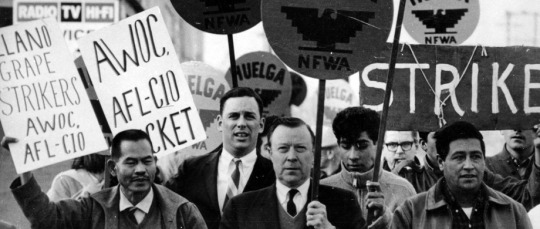
Delano Grape Strike led by Cesar Chavez and Larry Itilong.
Standing Rock and Alcatraz Strike
Another distinguishing strike was involving the Native Americans at Standing Rock, and Alcatraz. In April of 2016, the Standing Rock Sioux established the Sacred Stone protest camp at the confluence of the Cannonball and Missouri rivers in North Dakota. Companies began pipeline construction, and as a result, the Sioux began a protest because the pipeline’s draft environmental assessment did not address risks to their reservation’s water supply. Alcatraz is seen as a Historic Landmark and works with individuals and organizations to preserve and interpret its long history of activism.
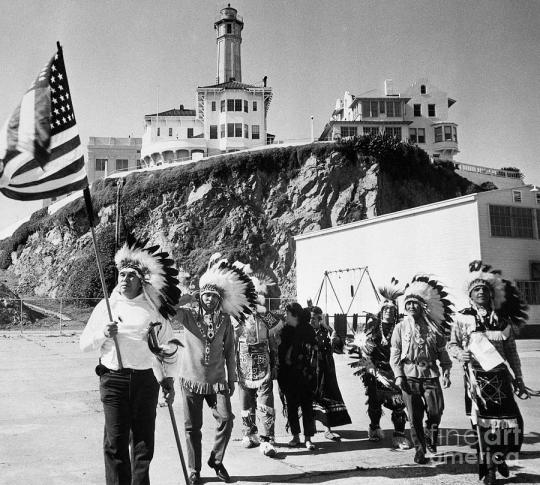
Native American Tribes occupying Alcatraz Island
Conclusion...
Strikes are history, strikes are what bring cohesion and unity amongst the unique ethnic groups involved. It is a way for their voices to be heard in this ever-loud country we live in. Strikes are necessary because if a group does not strike, then how can we be heard?
LEARN MORE BELOW!
youtube
youtube
youtube
Sources:
Epstein, K. K., & Stringer, B. (2022). The Student Strike that Won Ethnic Studies and Black Student College Admissions. Journal of African American Studies, 26(4), 503–513. https://doi.org/10.1007/s12111-022-09598-y
Contemporary Asian America. (n.d.). Google Books. https://books.google.com/books?hl=en&lr=&id=0ygUCgAAQBAJ&oi=fnd&pg=PA25&dq=history+of+ethnic+study+strikes&ots=kTOQuCtrQ3&sig=3WdaRHhIg3m9AA20FDbLvEnIe1o#v=onepage&q=history%20of%20ethnic%20study%20strikes&f=false
Lambert, A. M. (2021). Cesar Chavez: The 1965 Grape Boycott and the 400-Mile Pilgrimage.
Beisaw, A. M., & Olin, G. E. (2020). From Alcatraz to Standing Rock: Archaeology and Contemporary Native American Protests (1969–Today). Historical Archaeology, 54(3), 537-555.
FUNG, C. (2014). “THIS ISN’T YOUR BATTLE OR YOUR LAND”: THE NATIVE AMERICAN OCCUPATION OF ALCATRAZ IN THE ASIAN-AMERICAN POLITICAL IMAGINATION. College Literature, 41(1), 149–173. http://www.jstor.org/stable/24544625
Tintiangco-Cubales, A., Kohli, R., Sacramento, J., Henning, N., Agarwal-Rangnath, R., & Sleeter, C. (2015). Toward an ethnic studies pedagogy: Implications for K-12 schools from the research. The Urban Review, 47, 104-125.
0 notes
Text
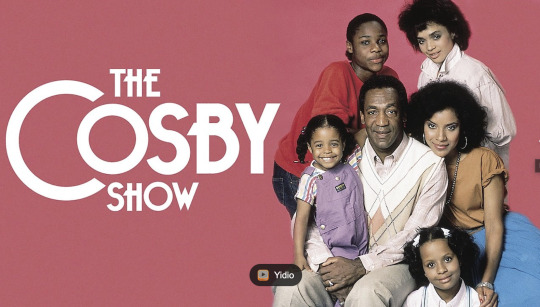
Black TV Shows In The 90s
By Bryce MacMillan
In the beginning...
In the 1980s black sitcoms came to screens around the country, the first big black TV show was "The Cosby Show." Before the ‘90s, there wasn’t much of a difference in what black and white audiences were interested in viewing. The Atlanta Journal-Constitution reports that in 1996 Black Television Viewing showed that in the 1985-86 season, 15 of the top 20 shows among black viewers were in the top 20 for white viewers. You may be asking why there were so many black TV shows that aired in the 90s and why there are not as many today. Well, after "The Cosby Show" networks saw a pattern that white audiences were tuning in to watch these shows as well. Wanting to capitalize on this, they began to pump out black TV shows to catch the eye of all colored and non-colored youth. Newer networks such as Fox and The WB wanted to establish themselves more with a black audience so they featured black sitcoms to draw in viewers and make more money.
But why after the 90s did black TV shows slowly disappear? The New York Times states that from 1997 to 2001, the number of Black sitcoms on TV in the U.S. dropped from 15 to 6 and sadly, it had a lot to do with declining viewership and ratings. Meaning that even the extremely popular Black TV shows weren't able to compete with mainstream shows. But, there was another reason. Dr. Robin R. Means Coleman, the Vice President and Associate Provost for Diversity and Inclusion at Northwestern University, says that it also had a lot to do with networks attempting to profit off of Black shows without paying to care about the quality of the shows. This means for the networks it was quantity over quality just to try and make more money. Another notable fact is that some, if not all of these shows were also extremely offensive to black culture. They made crude and obnoxious jokes that were not even close to hitting the mark on how colored people act. Some shows really played into the stereotypical black tropes that can still be seen today in movies and TV shows. Some of these tropes are "the all-powerful" black person, the over-the-top outrageous funny one, and various jokes that offended black culture.
Today...
Colored people still feel underrepresented, a study in 2019 said that 7 out of 10 colored people felt underrepresented on the screen and they wanted more TV shows and movies showing the diversity of the black American experience. Now, black storytelling has come back to the screen. It has in sitcom form with “Black-ish” and with dramas including “Queen Sugar.” But this did take time, one example is ABC’s brilliant sitcom, Black-ish, which was the first Black comedy to air on network television in over five years.
To conclude...
All in all, black TV shows in the 90s were made to profit off of all audience members no matter the race or color of their skin. The whole situation was a money scheme. Although these shows did bring black individuals to the screen, they were now included in a world they were not a part of before. So, yes it was a money scheme for networks and it became increasingly obvious when companies started to produce quantity over quality, but it was a step in the right direction for colored people to be included and represented on screen.
Want to learn more!
Sources...
0 notes
Text
Filipino Farmworkers Movement
By Christian Buco
Background
Filipino began arriving in the United States to be immigrants and seek economic opportunities in agriculture. Farmworkers faced harsh working conditions, racial discrimination, and low wages. An example, Workers faced harsh and unsanitary working conditions in the fields. Long hours of labor under the sun without breaks, lack of clean water and restroom, and exposure to harmful pesticides.
youtube
Delano Grape Strike
Agricultural Workers Organizing Committee (AWOC), a group of Filipino farmworkers, demanded a raise both on hourly wages and piece rate. Hourly wage from $1.25 to $1.40. Piece rate from ten cents to twenty-five cents a box of grapes packed.

The strike was led by two people, Larry Itliong and Ben Gines. Cesar Chavez was the leader of National Farm Workers Association (NFWA), a Mexican farmworkers, joined the strike. The growers refused to negotiate with the farmworkers and hired replacement workers from Oregon, Texas, and Mexico to complete the fall 1965 harvest.
The Boycott Campaign
NFWA first boycott targeted Schenley Industries, second largest grower in Delano. Schenley is known for liquor sales each year. Organizers and volunteers picket businesses like grocery stores, bars, and liquor stores that sold Schenley products. NFWA targeted the exclusion of farmworkers from the National Labor Relations Act, which led to growers to refuse to recognize farmworker unions. The passage of Civil Rights Act of 1964 created new framework for farmworker organizing. Chavez argued to U.S. Senate Subcommittee on Migratory Labor in 1966. This grant farm workers the right to form unions and bargain with grower.

"The whole system of occupational discrimination must be killed just like the discrimination against people of color is being challenged in Washington. This, and nothing more, is what farmworkers want." -Chavez
March to Sacramento
UFW organized a march from Delano to Sacramento in 1966. Most of them Mexican American and Filipino. 280 miles to the north. This symbolized the unity between different ethnic groups in the farm labor movement.
Victories
The movement led to the California Agricultural Labor Relations Act. This legislation helped farmworkers the right to organize and bargain collectively. The Filipino farmworkers movement help influence labor rights and social justice activism.
People involved
Cesar Chavez is a labor leader and civil rights activist who played a pivotal role in the farm labor movement in the United States. Co-founder of the United Farm Workers (UFW) union and lead nonviolent protests and strikes to improve working conditions of agricultural laborers. He was focused on the rights of Mexican and Filipino farmworkers.
Larry Itliong was a Filipino labor leader and a key figure in the farm labor movement. He initiated the Delano grape strike in 1965 and was the reason for the formation of the UFW union. He collaborated with Cesar Chavez.
Philip Vera Cruz was a Filipino labor leader and farmworker activist. Like Larry Itliong, he was a key figure in the farm labor movement. Contributed to the movement's success and the fight for fair labor conditions.
Summary
youtube
The Filipino farmworkers movement was centered in California. Filipino and Mexican advocated for improved working conditions, fair wages, and the right to collective bargaining. The movement was a key event that helped with farm labor rights. It contributed to a broader understanding of the importance of unity and collective action in the fight for social and economic justice. It is still impactful because it will be ongoing to improve conditions for workers across different industries.
Sources
0 notes
Text
Injustice in the Medical Field
by: Nguyen Truong
Racism is a Serious Threat to the Public’s Health
First off, when someone from a different ethnic or racial background seeks medical attention, they may encounter unjust treatment or prejudice. This is referred to as racism in healthcare. This can occur in several ways, such as getting worse care or not being given enough credit by medical professionals. It's significant because, regardless of appearance or origin, everyone is entitled to the greatest treatment available. Racism has a detrimental effect on people's lives, communities, and society at large. As such, racism poses a major risk to public health. It has far-reaching implications as a public health emergency in addition to being a social problem. This is the reason it's critical to comprehend:

Impact on Health Disparities: Racial and ethnic variations in health outcomes and access to healthcare services are caused by racism, which is a major contributor to health disparities. For underprivileged populations, these differences lead to greater prevalence of chronic diseases, shorter life expectancies, and worse general health.
Psychological and Emotional Impact: For people who are subjected to prejudice and discrimination, racism can have a deleterious impact on their mental health, leading to stress, anxiety, and trauma. These psychological effects can impair general well-being and result in long-term health problems.
Structural Racism In Historical
What then causes this to occur? Regretfully, it has its roots in a lengthy history of discrimination and inequality. People of color have long experienced marginalization and mistreatment within the healthcare system. For many areas, this has resulted in uneven access to medical services, increased prevalence of specific health disorders, and shorter life expectancies. The term "structural racism" describes the ways that prejudice, unfair treatment, and discrimination—both past and present—are ingrained in society's structures and processes. It's not just about isolated instances of prejudice; it's also about larger trends and laws that support inequality and harm certain racial or ethnic communities. Here is a concise explanation of structural racism from the perspective of history:
Historical Origins: The legacy of colonialism, slavery, and discriminatory laws and practices that have molded communities for millennia are the main causes of structural racism. The treatment and possibilities available to various racial and ethnic groups have been impacted negatively by these historical injustices.
Structural Racism Affects Healthcare
Numerous racial and ethnic groups' health outcomes, access to services, and level of treatment are all adversely affected by structural racism in the healthcare system.

To help you understand how systemic racism affects healthcare, consider the following basic explanation: Care Quality: When compared to their white counterparts, communities of color frequently obtain healthcare services of worse quality. This may be the result of institutional disregard for the health needs of marginalized populations, prejudices and preconceptions among healthcare professionals, and an uneven allocation of resources. Health inequalities: Racial and ethnic minority groups have a greater incidence of chronic diseases, shorter life expectancies, and worse overall health outcomes as a result of structural racism, which significantly contributes to these inequalities. The underlying causes of these discrepancies include uneven access to early detection, efficient therapies, and preventative care.
Here are these links so you can learn more.
0 notes